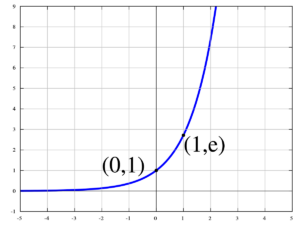Years ago in graduate school, I attended a class in ordinary differential equations that spent time studying things like the logarithmic behavior of earthquakes, the rate at which machinery wears out, and the exponential way things in nature, like gypsy moths, reproduce. You’re probably wondering what this has to do with COVID and I fully intend to tell you. But first, a short tutorial on exponential growth and how it explains the way we get from 2,900 deaths due to COVID in the US thus far to 250,000 deaths in two weeks as the President predicted last night.

The Natural Beauty of Mathematics: You’ve no doubt heard expressions such as “the stock market’s growing exponentially,” or “the half-life of plutonium-239 is 24,110 years due to it’s exponential decay.” Expressions like these describe the rate at which something rapidly changes. I have thus far been charting COVID data with linear functions, perhaps the most important and easiest to understand mathematical function. Exponential functions are a close second in importance while slightly harder to understand.
The easiest way to explain an exponential is that it’s a base number (fixed) raised to a power. Most folks are familiar with the simple exponential equation f(x) = 2^x, which is the number 2 raised to the x power. If x=2, this expression becomes 2^2 or two-squared, which equates to f(x) = 2*2 = 4.
The term “exponential growth” refers to a condition in which each time x increments by one value, the function increases by a multiple of its base. Exponential functions usually start out small and grow very rapidly (as shown in the above graph). In the previous simple example, f(x) = 2^x, each time x increments by one, the function doubles (because the base is two). For x = 1, 2, 3, 4, 5 . . .14; the function f(x) = 2, 4, 8, 16, 32, . . . 16,384. As you see, for a simple exponential like f(x)=2^x, after only fourteen cycles, f(x) grows from 2 to 16,384.
There’s a parable in the bible about a guy who helps a Pharaoh and as a reward the Pharaoh says he’ll give the guy anything he wants. Well the mathematically minded guy makes a simple request, he asks for a single grain of rice which should be doubled each day for one month (i.e., f(x) = 2^30). The Pharaoh, not being mathematically minded, quickly agrees and after 30 days ends up owing this guy 1.073 billion grains of rice, which was all the rice in his kingdom.
What does all this have to do with COVID and President Trump’s dire prediction? Well in order to get from 3,000 deaths thus far in the US to 250,000 deaths in two weeks, we have to follow some sort of exponential grow curve, but what curve? If f(x) = a^x, we know x=14 and f(x) = 250,000, but we don’t know the base number, (a). While I could dazzle and amaze you with complex formulas for deriving the base number, I could also sidestep all the drum rolling and tell you it’s 2.43, which results in f(x) = 2.43^14 = 250,315.
What this means is that if the federal models being used to predict that 250,000 Americans die in the next two weeks are based on exponential growth, then each day we should see the number of deaths increase 2.43 times over the previous day’s number. This is something you can track to estimate for yourself how well mitigation measures are working. It should be noted though that while federal models probably use more sophisticated equations, they won’t behave that much different.


I like following your commentary. Please add me to your list of members. Jeff Philbin, PnD Nuclear Engineer, Sandia National Laboratories, Albuquerque, NM
Thanks Jeff, I will
ron
I am also writing to make you understand of the cool discovery my wife’s princess obtained reading the blog. She came to understand several details, with the inclusion of what it’s like to possess a marvelous helping style to make a number of people easily know some impossible issues. You truly did more than our expectations. Thanks for presenting such valuable, healthy, revealing and even cool thoughts on the topic to Julie.